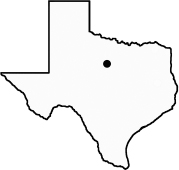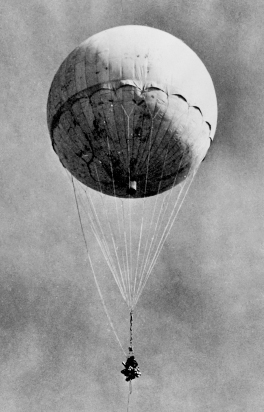
JAPANESE BALLOON BOMBS

In the early spring of 1945, the state of Texas was bombed by Japan.
Let me repeat that.
In the early spring of 1945, the state of Texas was bombed by Japan.
There were no casualties because the Japanese bomb’s payload was lost, probably over the Pacific. In fact, the attack may not have been reported at all if it had not been spotted by a handful of Desdemona teenagers.
On March 23, a fourteen-year-old boy named C.M. Guthery rode a bus home after a day of classes at Desdemona ISD. As he stepped off at his stop, he saw what looked like a massive basketball quickly descending from the sky. He followed it for a moment at a walk and then continued after it at a jog.
Guthery ran almost two miles before the “basketball” touched down, and by the time he got to it, kids from a different bus had already surrounded it. It was an enormous gray balloon with a large, faded “rising sun” illustration near the top.
Several of the children began examining the balloon, snatching guide-rope lengths and pieces of the surprisingly brittle balloon fabric. Guthery hung back. “The thing smelled bad,” he told Texas Almanac editor Mike Kingston in 1992. “Something like creosote…so I didn’t fool with it.”
The next day, government officials showed up in Desdemona. They gathered up the remnants of the faulty incendiary at the landing site and then proceeded to the Desdemona school building to begin collecting the missing pieces.
While government officials were securing the Desdemona bomb, another bomb made landfall northwest near Woodson. That morning, Barny Davis Ranch cowboy Ivan Miller discovered a collapsed balloon—that he would later describe as being as big around as a house—while he was working cattle near his home. Like the Desdemona balloon, the Woodson balloon had a large rising sun depiction near its apex but featured several smaller rising sun images around the bottom.
When news of Miller’s find spread, several Woodson-area residents came by to see it and pilfered the landfall area. By the time government officials had finished up in Desdemona, they’d gotten word of the balloon in Woodson and spent the rest of the day there securing the site and gathering all the pieces snatched up by souvenir hunters.
In the cases of both Desdemona and Woodson, the early civilian responders to the balloon landfalls had no idea they had found anything other than big balloons. There were guide ropes and attachment apparatuses in the collapsed balloon skin but no explosives. On May 5, 1945, a group of picnickers in southern Oregon was not so lucky.

A Japanese “balloon bomb” airborne. Courtesy of the National Museum of the United States Air Force.
That morning, Christian Alliance Church reverend Archie Mitchell drove to the mountains near Bly with his pregnant wife and five young people from his congregation, ages eleven through thirteen. Just before Mitchell got to the picnic area, he dropped his wife and the kids off so they could hike the rest of the way. After Mitchell parked the car and began transporting picnic cloths and foodstuff to a good shady spot, Mrs. Mitchell and the children called to him indicating they had discovered something resembling a large balloon. Mitchell had been aware of low-key warnings regarding Japanese balloons landing in the area and loudly instructed the rest of the party to stay away from balloon. But it was too late. Mitchell heard a loud explosion and ran toward it. The munitions had killed everyone standing in the immediate vicinity.
The Japanese had begun launching balloon bombs in late 1944 in response to the Doolittle Raid. Between the first and the last day in April 1945, they launched nine thousand balloons, but fewer than one thousand reached the United States. Japan’s primary target had been the Pacific Northwest; they envisioned a series of forest fires that might divert manpower and instill fear in the American public.
Each balloon bomb was approximately thirty feet in diameter and seventy feet tall. The balloon itself was initially composed of five layers of paraffin rice paper and filled with hydrogen. Later versions were constructed of latex and fabricated silk. The payload included two incendiary munitions and one thirty-three-pound antipersonnel explosive. The balloons also carried thirty-six sand-filled paper bags that served as ballast. The Japanese launched them up into the jet stream so that the trans-Pacific crossing only took three to five days.
The first balloon bomb discovered stateside was found by two lumberjacks near Kalispell, Montana, in December 1944. Its origin was established by analyzing the sand from one of the balloon’s ballast bags, but American officials blacked out all news regarding the Japanese balloon bomb campaign because they didn’t want the enemy to be encouraged by confirmed landings or news of casualties. The Oregon picnickers were the only Americans killed by enemy action inside the continental United States during World War II.